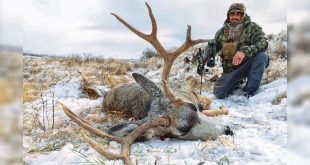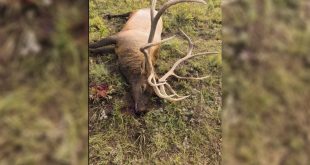Training Camp for Trophy Bulls
Brian Barney
A big bull elk is one of the most iconic animals to hunt out West. They weigh nearly 800 pounds with antlers that can stretch 5 ft. over their head. They travel immense amounts of country and when bumped or pressured can relocate zip codes away. Their senses are keen and they seem to have a knack for making the right moves, leaving hunters brokenhearted. A big, public land bull is one of the most prized trophies out West, and for good reason – they are extremely tough to harvest. If you are one of the lucky ones with a bull tag in your pocket, you want to make sure you are prepared. Nothing hurts the pride worse than tag soup. If you want to beat the odds and be one of the lucky ones kneeling behind a big 6-point, the work starts now.
Game Plan
I would say the #1 thing that stops a hunter from punching his tag is losing drive. Day in, day out hunting hard without seeing the bull you want wears on a guy. Stack a handful of days of tough hunting and guys start to lose faith and lose the drive to keep hiking and hunting hard. This is where working in the offseason to have a great game plan pays huge dividends. If you prepare yourself for these hardships and have a plan of attack, you just keep pushing. If you are packing in a camp, be prepared to move it to a different location. Elk are either there or they’re not. If you hunt for a handful of days and they are not there, time to move.
When I am hunting elk I like to cover country. I will pick one drainage and hike and hunt if for a day or two, then move on to the next. I will always do my map and Google homework in the offseason to have multiple options. I never put all my eggs in one basket when elk hunting. I make a plan A, B, C, D and so on. I make sure to have multiple backup plans, hiking and hunting multiple spots until I come up with a big bull. So make sure to study up and have a good game plan coming into season; it is a huge piece to the puzzle.
Mental Fortitude
Killing a big bull starts with having your mind right – elk will test your sanity. They travel through tons of country and it seems when you’re elk hunting they are either there, but usually not. There is a lot of mountain landscape that elk use but that does not mean they are there all the time. When elk hunting, you will look over miles and miles of country with hardly any elk in it. If you keep covering country, keep behind your glass at the right times, eventually you will uncover a hidey hole where the big bulls are living. So, to kill a big bull you have to be mentally strong and you have to keep pushing day after day. You have to be willing to be up hours before light and be hiking miles after the sun goes down. You have to keep the faith, even if you have not seen a bull for days. You keep after them and if they are not in one drainage, you move on to the next one and then the one after that.
Prepare yourself for hardships and know you will continue to push through them. The best way to gain mental strength is to be sure that you have prepared. You get your body in great physical shape, knowing you can handle the tax the mountain will levy against you. While you are training you are practicing the same skills and same mental fortitude it will take on a hunt. You set your workout schedule and then you hold yourself to it. You find a way to get your work out in which is the same drive it will take on an elk hunt; pushing day after day even when fatigued.
Physical Conditioning
Elk live in some of the wildest country the West has to offer. You will also find that elk love to walk uphill, which means you have to follow. This is where you should focus the majority of your training – elevation! Whether you are running or hiking, focus on getting your legs strong for the climb. It will not be the miles that get you, it will be the up and down. I feel like the down is just as important as the up, as it is tough on the body. The downhill hits home with me as I am typing this because my quads are so sore right now, I can hardly walk. A couple days ago I dove off a canyon after a bear. I lost a combined elevation of over 4,000 vertical feet. I have been training, but I guess not enough, as my legs still feel poisoned. If I was on a multiple-day elk hunt, I would be in big trouble as it is tough to even make it down my stairs. There is also a common injury to your IT band that happens from excessive downhill or side-hilling. It comes on as a sharp pain in the outside of your knee and gets worse with every step. I have had this myself and it is a hunt killer! It takes weeks or months to get healed up from an IT injury. It is preventable, it’s just a matter of getting in good elevation work outs teaching your muscles endurance.
Another important part of training is to make sure you get some work in with your pack. Either start doing some training with your pack or get in some early season scouting. It is important to prepare your back muscles for the constant weight of a pack. This is necessary due to nearly all the miles you will travel you will have at least a day pack on. Also, the pack out of one of these heavy critter puts a huge tax on your back. Nothing will cripple you on an elk hunt like putting your back out. So, make sure to get some workouts with your pack, getting the back muscles ready.
Working Out the Kinks
Mother Nature can be brutal during mid and late season elk hunts. Make sure you have your gear tested in order to stand up to the conditions. If you don’t have your shelter right or do not have the correct layers on, it can be game over. Take the offseason to test your gear and know it inside and out. Try to take your gear on realistic conditions like scouting missions. Your comfort and survival will count on that you have the right gear and know how to use it. Get yourself a good gear list to make sure you do not forget anything on your hunt. Make sure to include extra batteries for headlamp, rangefinder and GPS, if you use one. Take a portable charger for your cell phone if you use an onXmaps-type system.
Along with your gear list you should be continually working on your backcountry menu. If you are planning on day hunting, you can be more flexible taking in good foods with maybe some good leftovers. If you are truck camping you have options with being able to keep food in coolers. You backcountry guys have the biggest challenge, as after a few days those freeze-dried meals get old. Hiking and hunting around the mountains will burn a ton of calories; you can only sustain this with the right fuel. Try to shoot for 2000 – 3000 calories a day of good-tasting food. Be thinking of this throughout the offseason to come up with good ideas.
Weapons Training
If you want to be consistently successful, you must become best friends with your rifle. You can’t just sight in your rifle and think you’re ready for your chance at a big bull. It takes constant effort to be able to make the challenging shots the western mountains require. If you don’t put in the work, you will miss. I have seen it too many times even with good shooters; it’s not a given to make a good shot. I always start with getting my weapon dialed in. I will work on finding a good load or factory ammo that gets along with my gun. I do this all from the bench with perfect conditions, checking group sizes and then letting my barrel cool and cleaning my gun often.
Once you get dialed in from the bench and you know you are sighted in, time to start real life situations. One of my favorite targets is gallon jugs filled with water. It is about the size of a deer vital and explodes when you hit it. I will set up at real ranges I plan to shoot – 200, 300 and so on. I practice getting into shooting positions with just the gear I will have on a hunt. I get away from the bench here and start practicing prone, sitting, along with standing offhand and shooting off a tripod. Every situation will be different on elk and sometimes a prone shot is out of the question. Be prepared for all situations and be practicing for real hunting scenarios.
Shells are expensive nowadays and it is not always possible to buy hundreds of shells. While live shooting is super-important, one of the biggest tools you can use is dry firing. Now, it’s still up in the air if this is bad for your rifle, so you can always buy snap caps to be safe. These are a tool that allows you to dry fire without doing damage to your firing pin. You can then practice multiple times a week. Same thing here, practice real hunting scenarios. Start from standing with your pack on and get into your shooting position and execute your shot. It is tough to replicate the adrenalin that will surely be surging through you when you are shooting at a big 6 but you can get your heart rate up. Pushups and short sprints will do the job, then get to your shooting position. It is amazing how much this changes your aiming and it must be practiced. Some of this may seem like overkill but it is a thin line between success and failure; the prepared will come out on top more times than not.
If you have an elk hunt planned, you can either count on luck or count on your offseason preparation. Prove your dedication and put in the hard work now to come out on top. Big, public land bulls do not come easy and if you want to punch your tag, you have to be doing more than the next guy. So sharpen your skills and be ready when elk season rolls around.
 Eastmans' Official Blog | Mule Deer, Antelope, Elk Hunting and Bowhunting Magazine | Eastmans' Hunting Journals
Eastmans' Official Blog | Mule Deer, Antelope, Elk Hunting and Bowhunting Magazine | Eastmans' Hunting Journals




